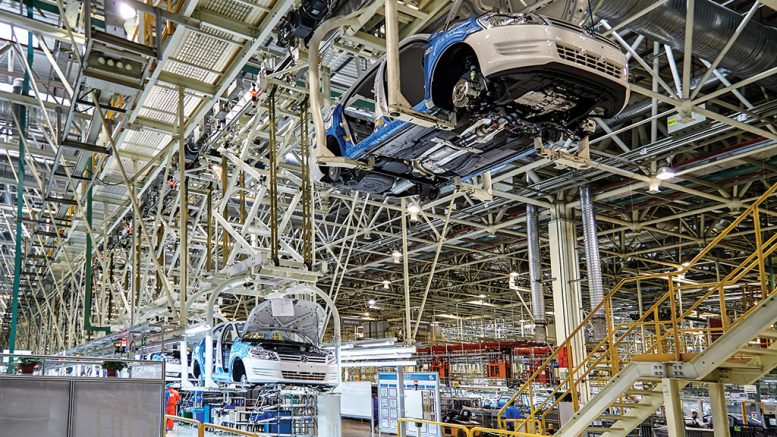As the United States posted its highest number of weekly coronavirus cases since the start of the pandemic and Americans headed to the ballot box in record numbers to cast their votes early for the country’s next president, China’s top leaders gathered for four days behind closed doors to craft their fourteenth Five Year Plan for 2021-2025.
The Five Year Plan has been a fixture of Chinese rule since 1953 – shortly after the Chinese Communist Party came to power in 1949 – and was modelled on the Soviet-style planned economy.
The economic blueprint can be a bland document short on details, which are typically fleshed out later, before being approved at the annual meeting of the National People’s Congress in March.
But what stood out loud and clear in the broad brushstrokes of the 14th five-year document is the importance Beijing is placing on self-reliance and innovation in technology, in particular strengthening China’s semi-conductor industry to provide the chips needed in high-end electronic devices and in everything from artificial intelligence and big data to 5G networking.
“It is the first time ever in the history of our party’s five year plans … that [China] is placing the plans on science, technology, and innovation before all other sectors,” China’s minister of science and technology, Wang Zhigang, told reporters following the Oct. 26-29 conclave. “We need to improve our ability to create things independently because we cannot ask for or buy the core technologies from elsewhere. … Given new changes in the domestic and international environment, we need technological solutions more than ever, and we need to strengthen innovation more than ever before.”
The subtext is China’s deteriorating relationship with the United States and the restrictions Washington has placed on Chinese tech companies like Huawei. In May, U.S. President Donald Trump increased the pressure on China’s largest telecoms equipment manufacturer with a new regulation that prevents the company or its suppliers from using U.S. technology and software. The new rule, penned The New York Times, “will block companies around the world from using American-made machinery or software to design or produce chips for Huawei or its entities,” and while “companies can apply for a license to continue supplying those products … the administration said the presumption would be to deny those requests.” Last year, the Trump administration put Huawei on a list of companies that could not be supplied with U.S. products without a license.
While China plans to reduce its reliance on foreign technology, it acknowledged that it needs to cooperate with the U.S. and the rest of the world. “We are willing to work with the world on climate change, energy change, public health, and support global experts on their studies, complete China’s legal environment, better protect intellectual property, and try to create a friendly environment for technology innovation in China,” Wang said.
The other major plank in the Communique is to boost growth by driving up domestic demand. “China has the world’s largest consumer market, which also possesses the greatest potential,” Xinhua, China’s state-owned news agency, quoted President Xi Jingping as saying. “The room for growth is huge.”
That is true, but don’t forget that while China is the world’s second-largest economy, roughly 373 million Chinese still live below “the upper-middle-income poverty line of US$5.50 a day,” according to the World Bank.
“Promoting common prosperity for everyone is a long-term task,” President Xi declared. “We must attach more importance to the promotion of common prosperity, setting off with firm steps and making sustained efforts toward the goal.”
Absent in the communique was a defined GDP growth target. The target in the current Thirteenth Five Year Plan is 6.5%.
Colin Hamilton, an analyst at BMO Capital Markets, said Beijing’s broader commitment to “further doubling China’s GDP and income per capita over 2020 levels by 2035,” works out to “real GDP growth of 4.6% over the coming fifteen years,” and reasoned that Beijing’s plans for “rural revitalisation” and “new urbanisation” will require “continuous infrastructure investment and emphasis on wealth distribution.”
And that’s good news for the mining industry and particularly for companies focused on metals such as copper used in “energy transition areas,” as China tries to meet its target of being carbon-neutral by 2060.
Qu Hongbin, chief China economist at HSBC, expects the five-year plan will increase the pace of household registration reform “to give the 290 million rural migrant workers access to urban social welfare,” a move that could raise GDP by 0.6 percentage points a year, as registration “will provide more opportunities to buy homes, obtain stable job contracts, and receive standard social-security benefits including pensions, education, healthcare, worker injury insurance and maternity benefits.” He estimated on the bank’s website that about 60% of the country’s population lives in urban centers but “not all are registered.”
Qu also anticipates that the move to “accelerate land reform” under the five-year plan is likely to “lift the income of 551 million rural consumers, boosting spending and adding another 0.4 ppt to GDP each year.”
In addition, he forecasts that China will “deepen financial reforms and liberalization, while expanding the role of the capital markets to reduce the misallocation of credit to state-owned enterprises rather than to smaller private firms.” That’s important, he said, given that the private sector accounts for more than 60% of GDP, 70% of innovation, 85% of urban employment, yet “receives less than 30% of the total credit.”
The bottom line: China’s appetite for metal will only accelerate.


Be the first to comment on "Editorial: China’s Five Year Plan prioritizes tech and domestic demand"